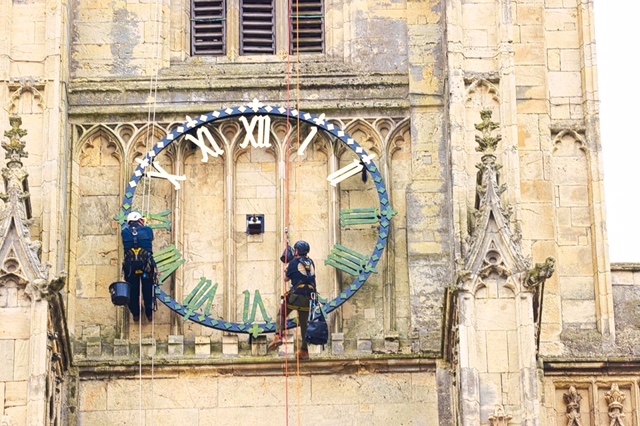
Re-gilding the Minster Clock
Early in June (probably from 8th) the Cumbria Clock Company will be starting work to restore the clock face.
The Friends approved spending on this some time ago but the project was delayed by the pandemic.
This contribution to the website provides some basic information on what is involved and touches on the history of the clock. I am indebted to Mike Robson for the information: Mike knows so much about all that is in – and goes on within – the towers (both mechanical and in terms of people) and he will be on site during the restoration to answer questions from the public. We hope this will be a good opportunity to recruit more Friends – as people abseiling up and around the clock face should attract much interest.
An earlier Minster clock was made by the famous clockmaker Harrison. It played nine tunes in a complicated rotation and must have been quite something to hear. But when new bells were installed in the early years of the twentieth century the clock was not strong enough to drive the hammers for the new bells.
The current clock was installed in 1902. Note that it had to be built to accommodate the most unusual arrangement whereby the chime and strike take place in two separate locations: the chime in the north tower and the hour in the south tower. As with so much in the Minster at this time, Canon Nolloth took the lead in the specification for the clock (and very probably helped too with its funding). The resulting clock mechanism weighs about two tons; it is built on a grand scale.

Then there was the matter of the chimes. Canon Nolloth took the then-organist (John Camidge) to the foundry and gave him the challenge of designing chimes that were neither boring nor repetitive. Not an easy task (ask the current director of music!). Camidge came up with the arrangement we still hear. The only change made to the clock mechanism was sometime in the 1950s, when hand-winding (which must have been a chore) was replaced by an electric motor.
So much for the clock, what about the dial. In the mid-1990s the clock stopped at 0630 (am and pm!) when a ‘bush’ broke. BP offered help to make a new system – free of charge. The hands were taken off and the churchwardens painted them with gold leaf (arguably not a ‘professional job’). Work on the dial itself was never completed – as it rained! Mike Robson can recall no work on the clockface during his 50+ years of work in the Minster.
What will happen this June? The workmen will take off the hands and check the mechanism that drives them. They will scrape off all the paint from the dial (which is 15 foot across). They will clean it and apply an undercoat, a primer and a top coat. The numerals will be painted in gold leaf. The hands will be checked and also painted with gold leaf.
All this will be carried out without scaffolding (and of course scaffolding is hugely expensive). The (two or three) workers will carry out all these tasks by abseiling and the work is expected to take eight days.
The work (which will cost in the region of £10,950) will be paid for by the Friends – who are also contributing to the current vital repairs to the nave roof.
Work in progress June 2021


